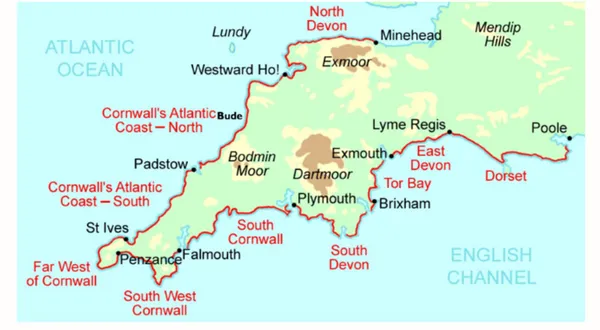About The South West Coast Path
The history of the world's best coastal hiking trail!
The South West Coast Path is a 650-mile adventure around the coastline of England’s south west peninsula. Starting at Minehead in Somerset it runs along the coastline of Exmoor, continuing along the coast of North Devon into Cornwall. It follows the entire coastline of Cornwall, goes across the mouth of the River Tamar and continues into Devon, after running along the south coast of Devon it then follows the Dorset coastline before finally ending at Poole Harbour.
Along the Coast Path you’ll discover the evidence left behind from millennia of people living, working and occasionally fighting along our coastline!
The Coast Path has a long history and much of it follows the route used by the coastguards and officers on the watch for smugglers. Right up until 1913 the coastguards regularly patrolled the whole length of the Path in the constant struggle to apprehend lawbreakers, they needed to be able to look down into every bay and cove and as a result, the Path closely hugs the coast providing excellent views but rarely the most direct path between two points.

There is a rich industrial heritage relating to quarrying, mining, lime burning and boat building along the Coast Path, trade with other coastal settlements near and far has also taken place over many centuries.
Mining in Cornwall began in the early Bronze Age, approximately 2150 BC. Tin and copper (as well as a few other metals e.g. arsenic, silver and zinc) were the most commonly extracted metals. During the 18th century, Cornwall was the mining centre of the world, famous for its base metal and tin production. At this time, the Cornish were considered the best hard rock miners in the world. Cornish mining led the industry with innovative technology, with much of this expertise later exported to mining regions around the globe, ultimately playing a significant part in growing various international economies.
But the glory days would see their end; in 1866 copper prices crashed, copper deposits were depleting, and new resources were being discovered abroad. By the late 19th century,y mining in Cornwall had diminished and only a small number of mines survived; however, tin mining continued long after the mining of other metals had become unprofitable.
Crashing copper prices resulted in a mass exodus of miners to international mining destinations. These Cornishmen took their expertise with them (and their Cornish pasties) and effectively populated the world’s mines.
Want to see more?
I have created curated maps, itineraries and more for travellers that want to travel like me.
Looking for things to do?
Go check out my guide for the best free things to do as well as itineraries and travel tips to make your trip unforgettable.

